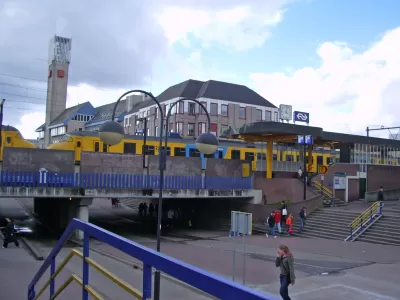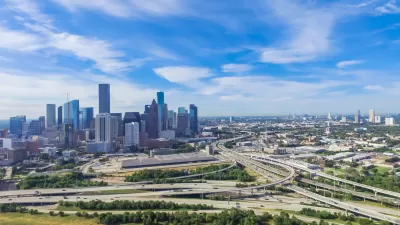Well-known in transportation planning circles, Houten's suburban multi-modality can be found almost nowhere else. Perimeter ring roads, train access, and bike-friendly features have cut car trips down to 44 percent.

First developed in the 1980s, Houten and adjacent town South Houten now house 50,000 residents. But with 66 percent of trips made by alternate modes, Houten isn't your typical suburb.
Eric Jaffe describes how Houten's layout restricts automobile movement: "Car traffic is primarily resigned to a 'ring road' that encircles the area. Within that ring is a network of low-speed streets meant primarily for people traveling on foot or by bike (there are 80 miles of bicycle paths alone) that connect to two main intercity train stations and most of the area's schools and shops."
If they commute to other areas by car, arriving drivers "exit the ring roads onto local streets in the core of Houten that extend into individual neighborhoods but don't connect to other parts of town. To get somewhere else by car, you have to get back on the ring road."
Other multi-modal planning features include comprehensive access to commuter rail, 18-mph speed limits, and streets reserved for walkers and cyclists. "The bike paths in the extensive cycling network have their own brick red coloring. Where bike routes do cross the ring roads, underpasses separate bike and car traffic."
It's doubtful whether the Houten model could work in the USA. To one American planner, Houten betrays a "Truman Show" artificiality: "Here you find a balanced transport system but little else." To be fair, longtime Houten residents probably feel differently about their home.
FULL STORY: A Case Study in Bike-Friendly Suburban Planning

Alabama: Trump Terminates Settlements for Black Communities Harmed By Raw Sewage
Trump deemed the landmark civil rights agreement “illegal DEI and environmental justice policy.”

Planetizen Federal Action Tracker
A weekly monitor of how Trump’s orders and actions are impacting planners and planning in America.

Why Should We Subsidize Public Transportation?
Many public transit agencies face financial stress due to rising costs, declining fare revenue, and declining subsidies. Transit advocates must provide a strong business case for increasing public transit funding.

Understanding Road Diets
An explainer from Momentum highlights the advantages of reducing vehicle lanes in favor of more bike, transit, and pedestrian infrastructure.

New California Law Regulates Warehouse Pollution
A new law tightens building and emissions regulations for large distribution warehouses to mitigate air pollution and traffic in surrounding communities.

Phoenix Announces Opening Date for Light Rail Extension
The South Central extension will connect South Phoenix to downtown and other major hubs starting on June 7.
Urban Design for Planners 1: Software Tools
This six-course series explores essential urban design concepts using open source software and equips planners with the tools they need to participate fully in the urban design process.
Planning for Universal Design
Learn the tools for implementing Universal Design in planning regulations.
Caltrans
Smith Gee Studio
Institute for Housing and Urban Development Studies (IHS)
City of Grandview
Harvard GSD Executive Education
Toledo-Lucas County Plan Commissions
Salt Lake City
NYU Wagner Graduate School of Public Service





























